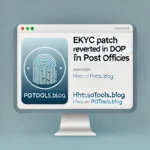Data Sanitization and IT 2.0 Operational Guidelines: A Seamless Rollout Process
The advancement of technology has brought about the need for stringent data security measures. In this context, data sanitization has emerged as a crucial step in ensuring that sensitive information is handled securely before being discarded or transferred. The IT 2.0 framework, in particular, offers guidelines and tools for effectively managing the data sanitization process, as outlined in the CEPT portal
https://access.cept.gov.in/datasanitization
Understanding Data Sanitization
Data sanitization refers to the process of permanently deleting data from storage devices in such a way that it cannot be recovered or reconstructed. This is essential for organizations handling sensitive or classified information, as it helps mitigate the risk of data breaches and ensures compliance with privacy regulations. IT 2.0’s data sanitization guidelines are designed to help users safely manage and delete data, especially when it is no longer required or when systems are being upgraded.

IT 2.0 Operational Guidelines for RMS
The IT 2.0 framework includes comprehensive Operational Guidelines for the Record Management System (RMS), which govern the procedures for data management and sanitization. These guidelines ensure that data is handled in accordance with the best security practices and compliance standards. Some key aspects of these guidelines include:
- Role-Based Access Control (RBAC): The guidelines define roles such as “maker” and “checker,” which are essential for the secure handling of data. The maker is responsible for initiating the data sanitization process, while the checker reviews and approves the process, ensuring accuracy and compliance.
- Secure Data Sanitization: The guidelines recommend secure methods for data sanitization, such as overwriting the data or physically destroying storage media, ensuring that the data is unrecoverable.
- Auditing and Monitoring: Every action taken during the sanitization process is logged and monitored to ensure compliance with organizational policies and regulatory standards.
- Access Control: Both private (e.g., Sify) and public networks are allowed to access the portal without any problem, ensuring that users can seamlessly access the platform from different environments without compromising security.
User Roles and Portal Access
Once the roles have been assigned to the maker and checker, users can access the data sanitization portal on the CEPT website. The portal provides an easy-to-navigate interface that guides users through the steps of initiating the data sanitization process, ensuring that the correct procedures are followed.
The portal’s access is designed to work smoothly on both private and public networks, ensuring that users can perform the necessary operations regardless of their network environment. The seamless integration of the access system with both networks makes it more convenient for users, with no significant access issues being reported.
The Rollout Process
The rollout process for IT 2.0 data sanitization involves the following steps:
- Accessing the Portal: After logging into the CEPT portal, the maker can initiate the data sanitization process. This process includes selecting the appropriate data that needs to be sanitized.
- Role Assignment: The maker initiates the process, and the checker reviews it for accuracy and compliance. Only after the checker’s approval can the data sanitization process proceed.
- Data Sanitization: Upon approval, the data is securely sanitized according to the operational guidelines. This includes ensuring that all sensitive information is properly erased and cannot be recovered.
- Audit and Reporting: The system logs each step, allowing for complete transparency and an audit trail of the actions taken.
Conclusion
Data sanitization is a critical component of any secure IT infrastructure. With the IT 2.0 Operational Guidelines for RMS, the process is made seamless and secure, enabling users to initiate and complete data sanitization processes effectively. The integration of role-based access control, secure methods for data deletion, and comprehensive monitoring ensures that organizations can maintain their data security standards and comply with privacy regulations. By leveraging both private and public networks for accessibility, users are empowered to manage sensitive data securely and with ease.
